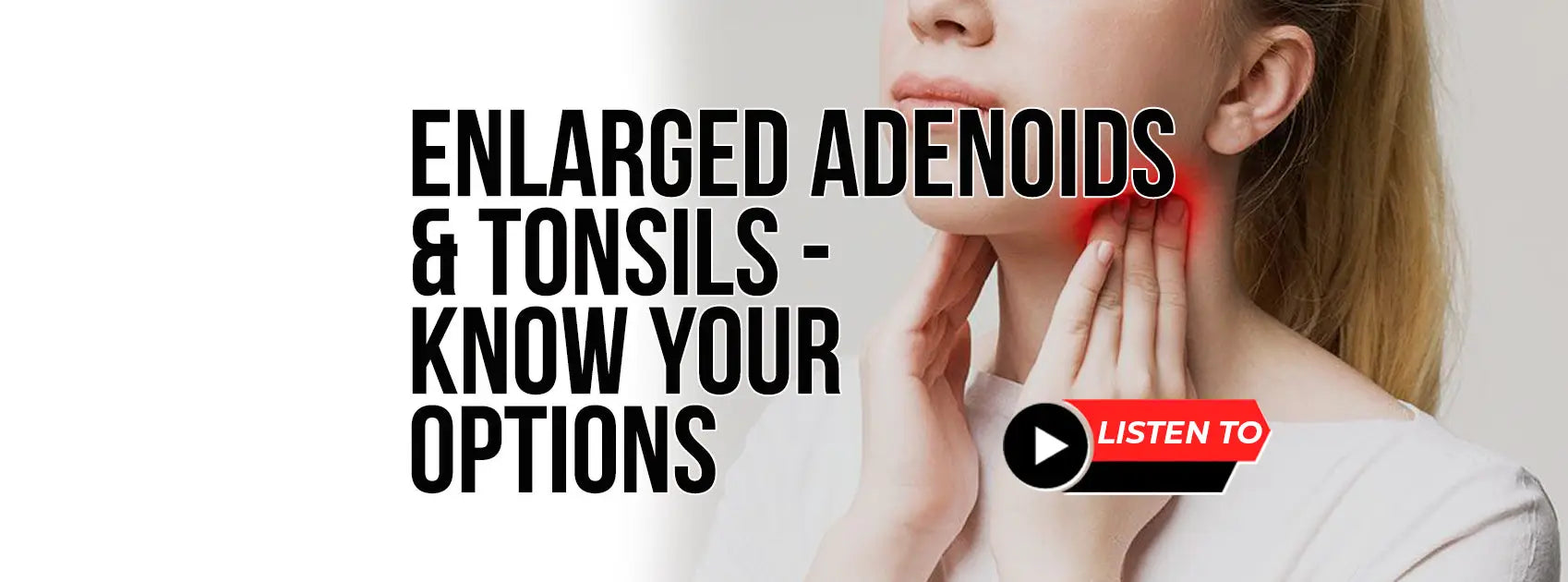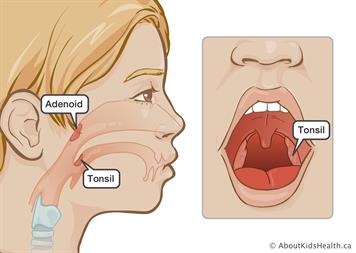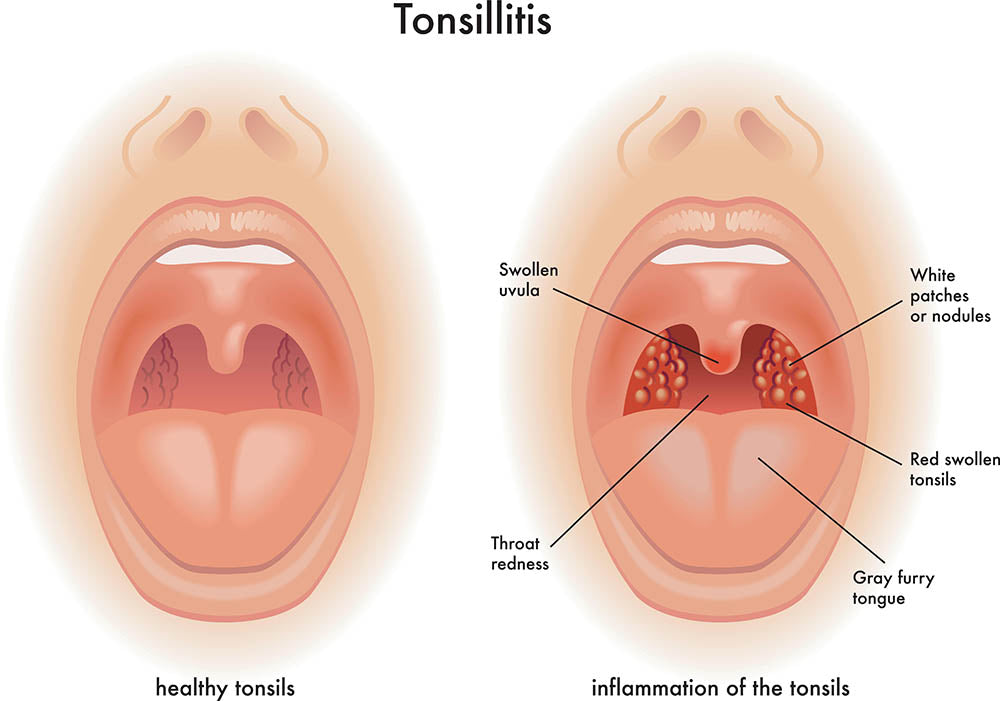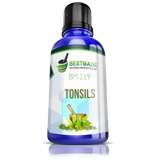
A GUIDE FOR ENLARGED ADENOIDS AND TONSILS

BM37 provides natural support for thyroid swelling and pain, tenderness in the thyroid gland, swallowing difficulty, hoarseness, hypothyroidism, and hyperthyroidism.
Tonsils are small round tissues situated on either side of your throat in the back part of your mouth. The adenoids are clumps of tissue situated behind your nasal cavities. Adenoids and tonsils serve the function of fighting infections but are prone to becoming enlarged when they are infected.

Enlarged adenoids and tonsils are also known as adenoiditis, tonsillitis, or adenoid and tonsil hypertrophy. An adult or a child with enlarged adenoids and tonsils might have trouble swallowing, a painful or sore throat, an ear infection, or suffer from sleep apnea.
What Causes Enlarged Adenoids and Tonsils?
Adenoids and tonsils become enlarged or infected for a variety of different reasons. Some of the common reasons include exposure to bacteria, viruses, parasitic and fungal infections, and even cigarette smoke.
The viruses that are commonly linked to enlarged adenoids and tonsils include:
- Herpes Simplex Virus
- Epstein-Barr Virus
- Influenza Virus
- Adenovirus
Some of the common bacteria associated with enlarged tonsils and adenoids include:
- Mycoplasma
- Haemophilus Influenzae Type B
- Neisseria Gonorrhea
- GABHS (Group A Beta-Hemolytic Streptococci)
In children, the risks for adenoid and tonsil infections will increase if come into close contact with other children that are already infected with a bacterial or viral infection
The Symptoms of Infection
The symptoms of enlarged adenoids and tonsils vary according to how severe the infection is and what caused it. These symptoms can develop over time or occur suddenly.

Tonsillitis Symptoms:
- Painful Swallowing
- Soar Throat
- Bright Red Tonsils
- Lost Appetite
- Bad Breath
- Fever
- Yellow or White Film on The Tonsils
Symptoms of Enlarged Adenoids
- Nasal Speech
- Breathing Through the Mouth Rather Than The Nose
- Constant Running Nose
- Snoring
- Recurring Ear Infections
- Sleep Apnea
BM96 naturally supports adenoid health. Recommended for pain, inflammation, and swelling. It may help you breathe easier. Useful for hypertrophy, infection of lymphoid tissue, repeated infection of the upper respiratory tracts, adenoiditis, and recurrent infection of the tonsils.
The Function of the Tonsils
Even though this organ is very small, it plays a vital role when it comes to maintaining your immunity. The tonsils help prevent foreign and harmful bodies or organisms from getting into the lungs. Tonsils also filter microorganisms, (that includes viruses and bacteria). The tonsils have immune cells that produce important antibodies that assist in destroying and eliminating germs which helps prevent throat and lung infections.
The AAO (American Academy of Otolaryngology) has stated that the tonsils act as our "first line of defense" for the immune system. They are also regarded as a defense against most inhaled pathogens. For example, the tonsils are believed to "sample" viruses and bacteria that attempt to enter the body through the mouth or nose, and then flush these with the assistance of lymph. Lymph is a Latin word that means "connected to water". This clear and colorless fluid is important to your circulatory and immune system.
BM5 provides natural support for a weak immune system. Useful for issues related to viruses, bacteria, and allergies. It may help with eliminating blood, food, and medicinal poisoning.
Findings from research and studies have suggested that tubal tonsils are able to actively transport different foreign antigens, (substances that cause an immune response), and operate as effector and inductive sites in our "mucosal" immune system. Certain study results have also shown that the different types of tonsillar organs play a unique and defining role in immune responses that are generated.
The Function of the Adenoids
Adenoids are actually classified as tonsils, yet not all the tonsil types are known as adenoids. There are 3 tonsil types within the lymphatic system. The adenoids are commonly known as pharyngeal tonsils. They perform the function of protecting the body against infections along with flushing away foreign and unwanted particles.
Adenoids are typically at their largest size in children between the ages of 3 and 5. They usually start shrinking between the ages of 7 or 8 and are just about invisible or barely visible in teenagers and then disappear by adulthood.
The adenoids feature a covering of mucus and cilia. The cilia are tiny hairs that wave around which spreads the mucus down into the pharynx. This mucus then travels into the stomach from the action of swallowing. The role of this mucus involves capturing dust, infectious bacteria, or any other foreign particles before flushing them away.
In addition to spreading mucus, the adenoids also create antibodies that help to protect you from illnesses and sickness.
Both the adenoids and tonsils assist with trapping pathogens that enter the nose or mouth. They also contain essential immune cells. These cells create antibodies that then destroy pathogens before they are able to enter or spread through your body.
Enlarged Vs Infected Adenoids and Tonsils
Many children have enlarged adenoids or tonsils. This can cause the airways to narrow which can result in snoring or they may stop breathing for a few seconds at a time while sleeping. When the sleep of the child is negatively impacted over a long period of time it called Obstructive Sleep Apnea and it can cause a variety of problems. In some cases, doctors may suggest surgery in order to remove either the tonsils, adenoids or both.
Some children suffer from enlarged Palatine tonsils, these are more commonly called "tonsils" and are situated on the right and left sides of the throat. Other kids may have enlarged adenoids, which are known as the pharyngeal tonsils, these are located closer to the back part of the child's nose. The medical terms that are used to describe these health issues are "adenoid hypertrophy" and "tonsil hypertrophy". In some cases, the tonsils and the adenoids will become enlarged at the same time.
Adenoids should not be confused or mistaken for nasal polyps. The nasal polyps are growths that are benign that develop inside the membrane lining of the nose. These typically only develop in adults. Enlarged tonsils should also not be confused or mistaken for tonsillitis (inflammation of the tonsils). These are medical conditions that are different.
The Symptoms of Enlarged Adenoids & Tonsils
Common symptoms of enlarged adenoids or tonsils typically include:
- The person will start breathing mainly through their mouth instead of their nose
- Snoring
- Pauses that are brief during sleep
- Restless sleep, bedwetting, and waking frequently
- Strained breathing
- Unusual sleeping positions (knees drawn into the chest, or head bent back)
- "Hot potato" speech
- Trouble swallowing
- Frequent colds

The primary symptoms usually depend on factors linked to whether the adenoids or palatine tonsils have become enlarged. Enlarged adenoids will mainly affect the individual's ability to breathe comfortably through their nose. On the other hand, enlarged palatine tonsils are mainly responsible for conditions such as sleep apnea when the person stops breathing for short periods of time while they are sleeping.
When the tonsils are diagnosed as or become infected, this is called tonsillitis. While it is more of a childhood illness it can also affect adults. It is most frequently diagnosed in children from preschool-age to their mid-teens. Tonsillitis is regarded as contagious and is most commonly caused by bacteria and viruses like Streptococcal bacteria. Streptococcus also causes something known as strep throat. When strep throat causes tonsillitis, it can result in serious and significant complications especially when left untreated.
What Is Adenoiditis?
The adenoids are located higher-up behind the roof of the mouth and the nose and are also prone to infection. Adenoids serve the purpose of filtering out foreign particles and germs from the body, in some cases they can become overwhelmed by a virus or bacteria which causes them to become infected. Inflamed and enlarged adenoids are called adenoiditis. This condition can make it hard to breathe and it results in recurring infections that are respiratory-related
While this condition is a lot more common in children, it can also affect adults.
What Are the Available Treatment Options for Enlarged Adenoids And Tonsils?
When diagnostic testing has concluded that the infection is caused by bacteria and it is not viral, most doctors will prescribe antibiotics.
Since antibiotics can only treat bacterial infections effectively when a virus is the cause of the infection most treatments are focused on providing relief or comfort from the common symptoms associated with these infections.
The treatment options for a viral infection to reduce the swelling and the pain include:
- Nasal Sprays
- Saline nasal rinses
- Throat lozenges
- Increasing fluid intake
- Acetaminophen

When a child or adult experiences frequent adenoid and tonsil infections, some health care providers will suggest the procedure known as T&A (tonsillectomy and adenoidectomy). This is when tissues that are diagnosed as chronically infected are removed. It has been a common procedure for both the adenoids and tonsils to be removed at the same time. However, some doctors will suggest removing only what is absolutely necessary.
A Natural Approach to Treat Enlarged Adenoids and Tonsils
From a holistic perspective there are 3 main areas to consider when it comes to swollen adenoids and tonsils.
1. Establish the Cause of Inflammation
If you are not sure what is causing the problem, it is impossible to address it. It is always advisable to consult with a qualified and experienced health practitioner to assist you with this.
When your child suffers from enlarged adenoids or tonsils, (or both) and you are aware they have allergies or intolerances, start by removing these first. Don’t know if your child has allergies? Then you may want to start with a dairy-free diet for a period of 6 weeks and then revaluate the situation. Clinical studies suggest dairy is often a contributing factor to inflammation, which includes problems with the adenoids and tonsils.
2. Build Up Immune Tolerance
Many people are known for going overboard when trying out restrictive diets, which can limit your nutrient intake significantly. The most important step involved in all types of elimination diets is to build up a tolerance. When you start building up the immune system, you may find you are able to tolerate different environmental substances and foods without them causing inflammation.
One of the essential steps involved in building up a tolerance is to balance the bacteria in the gut. Vitamin D is another important element. There are also many herbs that are effective when it comes to building tolerance. A naturopath or holistic healthcare provider is an excellent source to guide you through health options for yourself or your child.
3. Heal the Gut
The last step of the process is probably the most important one; you need to heal your gut to lower any inflammation that may be occurring there. You need to reduce or even eliminate food that causes inflammation such as gluten and dairy. Not every person would have to remove this type of food. This is why it is important to seek expert, professional and experienced advice.
To take this one step further, you should also be focusing on things that will support these healing processes. Gelatin and bone broth are both excellent sources to heal and soothe the lining of the gut.
Zinc is also important for both gut and immune health. Glutamine is another beneficial nutrient for the lining of the gut. These are nutrients that naturally occur in many of the foods that we eat. If you or your child has an impaired gut, you can ask your doctor or health care provider to recommend these nutrients in supplement form to help to boost gut health and immunity.
Other Supportive Therapies
There are also other types of modalities that can help with enlarged adenoids and tonsils.
Orofacial Myotherapy:

This is not a well-known therapy but it is focused on establishing the correct oral function along with encouraging the correct breathing (through the nose and not the mouth). Enlarged tonsils can often cause a child to become a mouth breather, which contributes to increased inflammation. Mouth breathing often also causes problematic sleep patterns.
Cranio-Sacral Therapy:
This is another effective and natural approach to treating conditions such as enlarged adenoids and tonsils. This form of gentle bodywork is focused around relieving compression present in the back, neck, and head.

Tonsils and adenoids are small but mighty organs that help protect your body from airborne bacteria and viruses, because of their job they often are inflamed or infected. For cases of chronic infection and inflammation doctors often suggest invasive surgery without fully exploring natural options. Hopefully, this article has made you aware of all the alternatives so you can make an informed treatment decision for yourself or your loved one.
Wyethia He is designed to support your body when dealing with pain and inflammation in the throat.BM172 is recommended for tonsilitis, pain in the throat, difficulty eating, difficulty swallowing, ear pain, fever, chills, enlarged and inflamed tonsils, and high to moderate rise in the body temperature.BM119 may help your body to deal with tonsil problems, including enlarged tonsils, adenoids, croup, headache, catarrh, sneezing, chills, fever, facial neuralgia, and cough.








I have two questions. What remedy do you suggest for swollen parotid glands, and is it ok to take remedies together if you are using more than one?
Thank you
Leave a comment